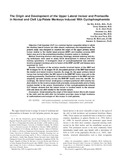| dc.contributor.author | Xin, Wei | |
| dc.contributor.author | Senders, Craig | |
| dc.contributor.author | . Owiti, G. O | |
| dc.contributor.author | Xiaoming, Liu | |
| dc.contributor.author | Zhen-nian, Wei | |
| dc.contributor.author | Dillard-Telm, Lisa | |
| dc.contributor.author | McClure, Harold M. | |
| dc.contributor.author | . Hendrickx, Andrew G | |
| dc.date.accessioned | 2013-06-14T07:07:13Z | |
| dc.date.available | 2013-06-14T07:07:13Z | |
| dc.date.issued | 2000-11 | |
| dc.identifier.citation | The Cleft Palate-Craniofacial Journal: November 2000, Vol. 37, No. 6, pp. 571-583 | en |
| dc.identifier.uri | http://www.cpcjournal.org/doi/abs/10.1597/1545-1569%282000%29037%3C0571%3ATOADOT%3E2.0.CO%3B2 | |
| dc.identifier.uri | http://erepository.uonbi.ac.ke:8080/xmlui/handle/123456789/33569 | |
| dc.description.abstract | Objective: Cleft lip/palate (CLP) is a common human congenital defect in which the maxillary lateral incisors are often absent, malformed, and malpositioned. The present study was designed to examine the origin of the upper primary lateral incisor relative to the medial nasal process (MNP) and maxillary process (MP) fusion area and to the premaxillary/maxillary (incisive) suture in monkeys.
Method: Scanning electron microscopy, histology, skeletal staining, and drying techniques were used to study facial development in embryo and fetal monkey specimens. A teratogenic dose of cyclophosphamide was administered to pregnant monkeys prior to fusion of the MNP and MP and fetuses were examined for CLP.
Results: Formation of the anterior maxilla involved fusion of the MNP and MP at stages 14–18. At stages 18–20, the palatal portion of the MNP had formed the medial and lateral incisive mounds. By stage 22, the upper primary lateral incisor has formed within the MP, lateral to the MNP/MP fusion area and to the ossifying premaxilla. Ossification of the premaxilla begins in the MNP and subsequently spreads laterally across the MNP/MP fusion area into the MP. Accordingly, the lateral incisor undergoes a complex positional shift (mainly medial) relative to the incisive suture both prenatally and postnatally and is finally located medial to the suture. Examination of the cyclophosphamide-induced CLP fetuses showed that the lateral incisor is located lateral to the alveolar cleft and does not shift medial to the incisive suture.
Conclusion: Understanding the origin of the lateral incisor (the tooth closest to the cleft) and the shift after its formation provides clues to high incidence of malformations and ectopia of this incisor in cleft patients. | en |
| dc.language.iso | en | en |
| dc.publisher | Univesity of Nairobi | en |
| dc.title | The Origin and Development of the Upper Lateral Incisor and Premaxilla in Normal and Cleft lip/palate Monkeys Induced with Cyclophosphamide | en |
| dc.type | Article | en |
| local.publisher | Department of Vetinary Anatomy and physiology | en |

